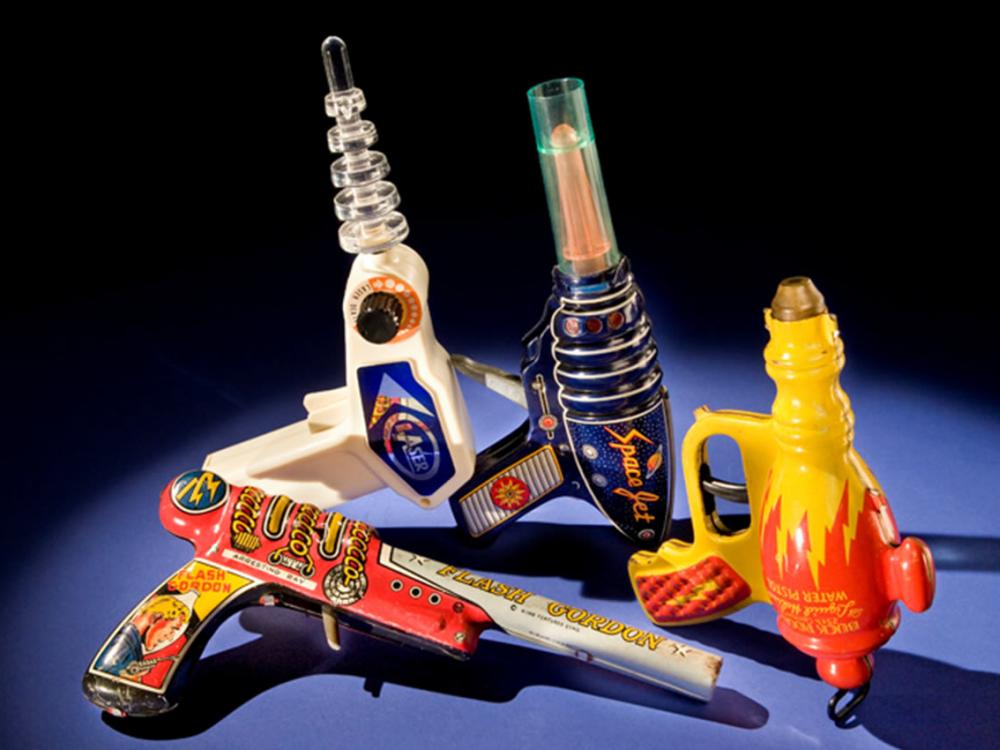
A Christmastime Price War—Over a Toy Ray Gun
Dec 15, 2011
By Margaret A. Weitekamp

Dec 15, 2011
By Margaret A. Weitekamp
Along the McDonnell Space Hangar’s south wall in the Steven F. Udvar-Hazy Center, a case of colorful toys beckons to visitors. Older patrons pause in nostalgia to identify the toys of their youth. Children plop on the floor by the Star Wars: The Empire Strikes Back action figures, studying early-1980s versions of characters they know through the Clone Wars animated series and video games. But ray guns dominate the display. Hung in a circle facing inward toward the curator’s fabulously-illuminating main label about the parallels between many space stories and American Westerns (make sure you read it the next time you’re there!), the ray guns show an array of different shapes, colors, finishes, and materials.
But most people fail to notice that the progenitor for all ray gun toys is sitting on the top shelf on the left: quiet, matte, black—and incredibly important. Given to the Museum by Michael O’Harro in the 1990s, this innocuous wood, metal, and plastic form was the model for the very first metal Buck Rogers gun: the XZ-31 Rocket Pistol, produced in 1934 by the Daisy Manufacturing Company of Plymouth, Michigan. That toy, which was wildly successful, even sparked a Christmastime price war between two of the biggest department stores in the country at the time.
Buck Rogers first appeared in the pulp magazine Amazing Stories in August 1928 as the character Anthony Rogers in Philip Francis Nowlan’s story “Armageddon 2419 A.D.” Knocked unconscious, the blond hero awakened in the 25th century to find America under attack from “Mongol” hordes, a reflection of the “yellow peril,” contemporary anxiety about Asians in the United States. National Newspaper Service president John F. Dille saw a potential comic strip—with one small change. Renamed “Buck” to tap into Westerns’ popularity, “Buck Rogers” (illustrated by Dick Calkins) debuted in 1929, followed by a color Sunday strip in 1930 and a radio program in 1932. (Created to compete with—and cash in on—that success, Flash Gordon began fighting another Asian enemy, Ming the Merciless, in comic strips in 1934.) Paper or cardboard Buck Rogers guns quickly become available as mail-away premiums, play kits, or give-aways. But as the comic strip and radio program gained popularity, Daisy Manufacturing Company wanted to make a three-dimensional toy: a metal ray gun. But the guns drawn in the comics were too intricate to produce. Instead, Daisy executives asked Buck Rogers illustrator Dick Calkins to redesign the guns shown in the comic to make them easier to replicate as three-dimensional toys. The matte black model shows a prototype, a variation upon which was eventually produced. The resulting XZ-31 Rocket Pistol launched with a dedicated display at Detroit’s J.L. Hudson department store, the props from which were then reused at the American Toy Fair to sell the toy to other shops. Macy’s flagship department store in New York City bought in, negotiating a one-week exclusive marketing agreement. On the first day the XZ-31 sold in New York City, 2,000 eager buyers lined up! By Christmas, a holster and helmet were also available for consumers who wanted to act out Buck’s adventures.
But once Macy’s exclusive agreement ended, the wild popularity of the metal 50¢ toy gun sparked a Christmastime price war between Macy’s and Gimbel’s department stores. At one point, the price at Gimbel’s reportedly reached as low as two-for-19¢, below the manufacturing cost! A year later, in 1935, inspired by the XZ-31’s success, Daisy created a smaller version named for the series’ female lead character, Wilma Deering. The XZ-35 Buck Rogers Rocket Pistol Toy was identical in every way to the original metal Buck Rogers gun—except for its reduced size. The National Air and Space Museum holds toys and games in the collection because they reflect how people have imagined spaceflight—and how children have been introduced to spaceflight through play, both realistic and fantastical. No matter how you celebrate this holiday season, consider making a visit to the Udvar-Hazy Center to see these fanciful reminders of how children of all ages have imagined their own futures in space.

We rely on the generous support of donors, sponsors, members, and other benefactors to share the history and impact of aviation and spaceflight, educate the public, and inspire future generations. With your help, we can continue to preserve and safeguard the world’s most comprehensive collection of artifacts representing the great achievements of flight and space exploration.
We rely on the generous support of donors, sponsors, members, and other benefactors to share the history and impact of aviation and spaceflight, educate the public, and inspire future generations. With your help, we can continue to preserve and safeguard the world’s most comprehensive collection of artifacts representing the great achievements of flight and space exploration.